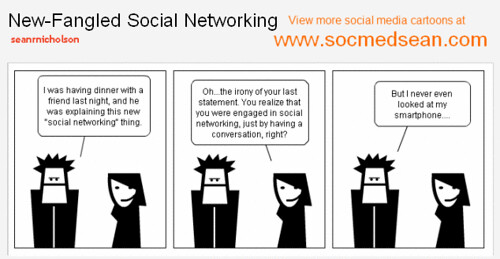Updating Twitter once a day, or ten times a day doesn’t make a difference.
These micro, tactical decisions might help a little. You might get one more click, or one more follower.
But it’s not going to move the needle from unprofitable to profitable.
Success in social media hinges on your mental approach. If you can evolve the way you think about using social media, then you’ll get 10x the results.
It will affect your strategy, and how you plan on integrating social media into the rest of your business.
And these little decisions, like which hashtag to use, will take care of themselves.
Here are 3 social media myths that are preventing you from succeeding (and how you can fix them immediately).

Image courtesy of seanrnicholson
Myth #1: Social Media Drives Sales
Social media doesn’t drive sales… it drives profitability.
It can’t directly convert customers, like Google AdWords. But it can significantly aid indirectly, by assuring first time visitors and getting current customers to increase their buying frequency with your brand.
Customer engagement is the vital link to increasing online sales.
Because people don’t buy, or become loyal without trust.
Customer trust is difficult to measure, but it’s absolutely essential to higher margins, and more profitability.
Loyal people will buy from you longer (when they could probably find the same product/service cheaper somewhere else), and they’ll refer you to their friends and colleagues (both online and off).
But before you can build trust and increase engagement, you need to drive more sales and increase awareness.
Which bring us to #2…
Myth #2: Social Media Drives Traffic
Social media doesn’t drive traffic… you (the marketer) does.
Throwing up a few Tweets on a Monday morning won’t get you hundreds of ReTweets and thousands of website visitors. Marketing doesn’t happen by chance.
What is the motivation for clicking on your tweet or visiting your website? What does the visitor get? Finding the motivation and underlying triggers of your customer segments is the first step to using social media.
Because the real work is done in advance, before you even go to share anything.
The thing you want to promote, has to be “promotable” in the first place. So it needs to be insanely useful, solves your customer’s pain points, it’s easy-to-understand (and share), and more.
Now what does the person actually get in return for clicking, sharing or opting-in? Maybe you use an incentive, or perhaps you’re touching on emotional trigger that compels people to take action.
Either way, you need to identify and align each traffic sources’ motivation with tailored calls-to-action, so your marketing messages become personalized and customized.
This will drastically increase your response rate, which gets more people to click, share or opt-in.
Myth #3: Social Media has Changed Marketing
Social media hasn’t changed marketing… it’s changed the delivery and distribution.
Most people assume that marketing = advertising. Maybe for large companies that’s true, because the only control the CMO has is over which ad agency to hire.
But real marketing is much more than this. And it impacts your business strategy on a day-to-day basis.
Marketing is responsible for the products or services you offer, how you deliver them, and how much you make on each sale.
So if you want to get better at social media, then you should start by getting better at psychology, because it will help you understand how to phrase an update or introduce a new product line.
You should get better at market research, because you’ll be able to design surveys that tell you exactly what your different customer segments want.
And you should get better at… advertising. Because understanding how to write sales copy and distribute a sales message to multiple channels will help you figure out which social media platforms you should even be on in the first place.
Because instead of direct paper mail, we’re now using email.
Instead of watching TV, we’re now watching YouTube.
The technology and tools have evolved for the better. We have more opportunities to reach customers than ever before.
But the same timeless marketing fundamentals, like how to tell a story and position your company in a crowded marketplace, still apply.
And these decisions will either deliver success, or prevent you from ever growing.


